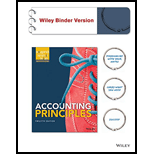
Accounting Principles 12E WileyPLUS with Loose-Leaf Print Companion with WileyPLUS Leanring Space Card Set
12th Edition
ISBN: 9781119036395
Author: Jerry J. Weygandt, Paul D. Kimmel, Donald E. Kieso
Publisher: Wiley (WileyPLUS Products)
expand_more
expand_more
format_list_bulleted
Concept explainers
Question
Chapter 21, Problem 21.3BE
To determine
Journalizing: It is the process of recording the transactions of an organization in a chronological order. Based on these journal entries recorded, the amounts are posted to the relevant ledger accounts.
Accounting rules for journal entries:
- To increase balance of the account: Debit assets, expenses, losses and credit all liabilities, capital, revenue and gains.
- To decrease balance of the account: Credit assets, expenses, losses and debit all liabilities, capital, revenue and gains.
To prepare: The
Expert Solution & Answer
Want to see the full answer?
Check out a sample textbook solution
Students have asked these similar questions
General accounting question
What is the total amount of assets?
Compute the gross profit.
Chapter 21 Solutions
Accounting Principles 12E WileyPLUS with Loose-Leaf Print Companion with WileyPLUS Leanring Space Card Set
Ch. 21 - Prob. 1QCh. 21 - Prob. 2QCh. 21 - Prob. 3QCh. 21 - Prob. 4QCh. 21 - Prob. 5QCh. 21 - Prob. 6QCh. 21 - Prob. 7QCh. 21 - Prob. 8QCh. 21 - Prob. 9QCh. 21 - Prob. 10Q
Ch. 21 - Prob. 11QCh. 21 - Prob. 12QCh. 21 - Prob. 13QCh. 21 - Prob. 14QCh. 21 - Prob. 15QCh. 21 - Prob. 16QCh. 21 - Prob. 17QCh. 21 - Prob. 18QCh. 21 - Prob. 19QCh. 21 - Prob. 20QCh. 21 - Prob. 21QCh. 21 - 22. (a) What are the principal differences between...Ch. 21 - Prob. 23QCh. 21 - Prob. 24QCh. 21 - Prob. 21.1BECh. 21 - Prob. 21.2BECh. 21 - Prob. 21.3BECh. 21 - Prob. 21.4BECh. 21 - Prob. 21.5BECh. 21 - Prob. 21.6BECh. 21 - Prob. 21.7BECh. 21 - Prob. 21.8BECh. 21 - Prob. 21.9BECh. 21 - BE21-10 Sam Snead has formulated the following...Ch. 21 - Prob. 21.11BECh. 21 - Prob. 21.1DIECh. 21 - Prob. 21.2DIECh. 21 - Prob. 21.3DIECh. 21 - Prob. 21.4DIECh. 21 - Prob. 21.5DIECh. 21 - Prob. 21.1ECh. 21 - Prob. 21.2ECh. 21 - Prob. 21.3ECh. 21 - Prob. 21.4ECh. 21 - Prob. 21.5ECh. 21 - Prob. 21.6ECh. 21 - Prob. 21.7ECh. 21 - Prob. 21.8ECh. 21 - Prob. 21.9ECh. 21 - Prob. 21.10ECh. 21 - Prob. 21.11ECh. 21 - Prob. 21.12ECh. 21 - Prob. 21.13ECh. 21 - Prob. 21.14ECh. 21 - Prob. 21.15ECh. 21 - Prob. 21.16ECh. 21 - Prob. 21.17ECh. 21 - Prob. 21.1APCh. 21 - Prob. 21.2APCh. 21 - Prob. 21.3APCh. 21 - Prob. 21.4APCh. 21 - Prob. 21.5APCh. 21 - Prob. 21.6APCh. 21 - Prob. 21.7APCh. 21 - Prob. 21CDCPCh. 21 - Prob. 21.1BYPCh. 21 - Prob. 21.2BYPCh. 21 - Prob. 21.3BYPCh. 21 - Prob. 21.4BYPCh. 21 - Prob. 21.5BYP
Knowledge Booster
Learn more about
Need a deep-dive on the concept behind this application? Look no further. Learn more about this topic, accounting and related others by exploring similar questions and additional content below.Similar questions
- Gabriel is the sole owner and operator of Giant Sky Services. As of the end of its accounting period, December 31, Year 3, Giant Sky Services has assets of $1,200,000 and liabilities of $350,000. During Year 4, Gabriel invested an additional $60,000 and withdrew $45,000 from the business. What is the amount of net income during Year 4, assuming that as of December 31, Year 4, assets were $1,100,000 and liabilities were $340,000?arrow_forwardWhat would be the depreciation expense?arrow_forwardThe average total asset amount isarrow_forward
- Lenin Systems purchased equipment on January 1 for $200,000. This system has a useful life of 10 years and a salvage value of $25,000. The company estimates that the equipment will produce 50,000 units over its 10-year useful life. Actual units produced are: Year 1 – 5,000 units; Year 2 – 6,500 units; Year 3 – 7,000 units; Year 4 – 5,500 units; Year 5 – 5,000 units; Year 6 – 6,000 units; Year 7 – 7,000 units; Year 8 – 3,000 units; Year 9 – 3,000 units; Year 10 – 2,000 units. What would be the depreciation expense for the second year of its useful life using the straight-line method? Helparrow_forwardSolve this questionarrow_forwardPlease explain the solution to this general accounting problem using the correct accounting principles.arrow_forward
arrow_back_ios
SEE MORE QUESTIONS
arrow_forward_ios
Recommended textbooks for you

 AccountingAccountingISBN:9781337272094Author:WARREN, Carl S., Reeve, James M., Duchac, Jonathan E.Publisher:Cengage Learning,
AccountingAccountingISBN:9781337272094Author:WARREN, Carl S., Reeve, James M., Duchac, Jonathan E.Publisher:Cengage Learning, Accounting Information SystemsAccountingISBN:9781337619202Author:Hall, James A.Publisher:Cengage Learning,
Accounting Information SystemsAccountingISBN:9781337619202Author:Hall, James A.Publisher:Cengage Learning, Horngren's Cost Accounting: A Managerial Emphasis...AccountingISBN:9780134475585Author:Srikant M. Datar, Madhav V. RajanPublisher:PEARSON
Horngren's Cost Accounting: A Managerial Emphasis...AccountingISBN:9780134475585Author:Srikant M. Datar, Madhav V. RajanPublisher:PEARSON Intermediate AccountingAccountingISBN:9781259722660Author:J. David Spiceland, Mark W. Nelson, Wayne M ThomasPublisher:McGraw-Hill Education
Intermediate AccountingAccountingISBN:9781259722660Author:J. David Spiceland, Mark W. Nelson, Wayne M ThomasPublisher:McGraw-Hill Education Financial and Managerial AccountingAccountingISBN:9781259726705Author:John J Wild, Ken W. Shaw, Barbara Chiappetta Fundamental Accounting PrinciplesPublisher:McGraw-Hill Education
Financial and Managerial AccountingAccountingISBN:9781259726705Author:John J Wild, Ken W. Shaw, Barbara Chiappetta Fundamental Accounting PrinciplesPublisher:McGraw-Hill Education


Accounting
Accounting
ISBN:9781337272094
Author:WARREN, Carl S., Reeve, James M., Duchac, Jonathan E.
Publisher:Cengage Learning,

Accounting Information Systems
Accounting
ISBN:9781337619202
Author:Hall, James A.
Publisher:Cengage Learning,

Horngren's Cost Accounting: A Managerial Emphasis...
Accounting
ISBN:9780134475585
Author:Srikant M. Datar, Madhav V. Rajan
Publisher:PEARSON

Intermediate Accounting
Accounting
ISBN:9781259722660
Author:J. David Spiceland, Mark W. Nelson, Wayne M Thomas
Publisher:McGraw-Hill Education

Financial and Managerial Accounting
Accounting
ISBN:9781259726705
Author:John J Wild, Ken W. Shaw, Barbara Chiappetta Fundamental Accounting Principles
Publisher:McGraw-Hill Education
What is variance analysis?; Author: Corporate finance institute;https://www.youtube.com/watch?v=SMTa1lZu7Qw;License: Standard YouTube License, CC-BY